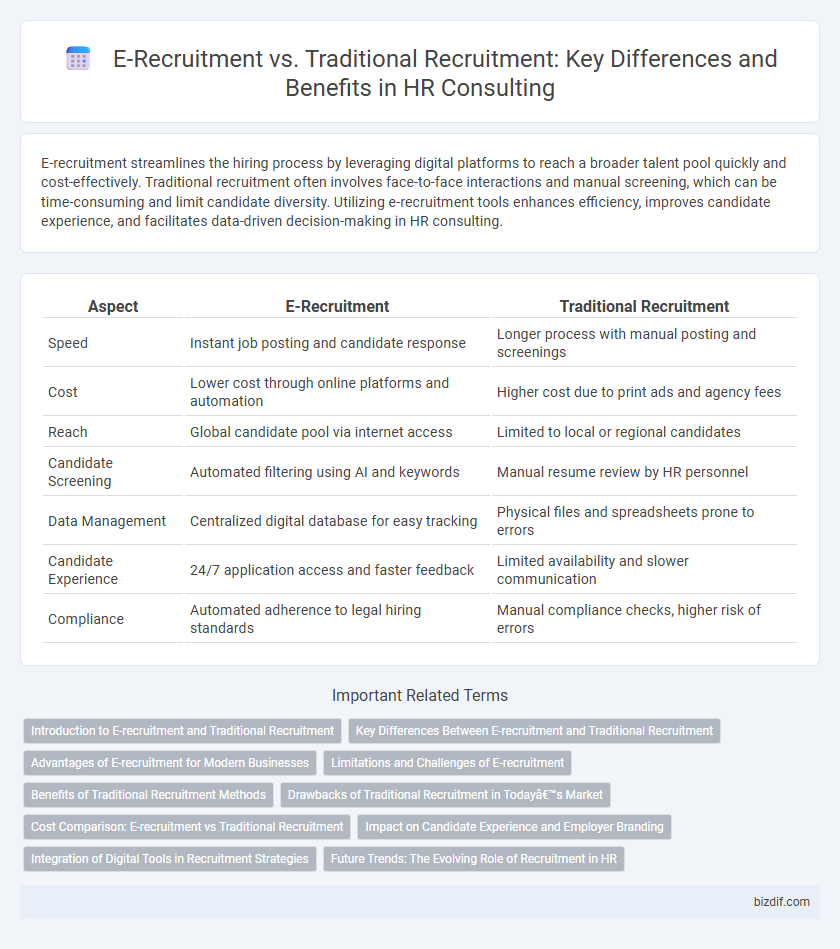E-recruitment streamlines the hiring process by leveraging digital platforms to reach a broader talent pool quickly and cost-effectively. Traditional recruitment often involves face-to-face interactions and manual screening, which can be time-consuming and limit candidate diversity. Utilizing e-recruitment tools enhances efficiency, improves candidate experience, and facilitates data-driven decision-making in HR consulting.
Table of Comparison
| Aspect | E-Recruitment | Traditional Recruitment |
|---|---|---|
| Speed | Instant job posting and candidate response | Longer process with manual posting and screenings |
| Cost | Lower cost through online platforms and automation | Higher cost due to print ads and agency fees |
| Reach | Global candidate pool via internet access | Limited to local or regional candidates |
| Candidate Screening | Automated filtering using AI and keywords | Manual resume review by HR personnel |
| Data Management | Centralized digital database for easy tracking | Physical files and spreadsheets prone to errors |
| Candidate Experience | 24/7 application access and faster feedback | Limited availability and slower communication |
| Compliance | Automated adherence to legal hiring standards | Manual compliance checks, higher risk of errors |
Introduction to E-recruitment and Traditional Recruitment
E-recruitment leverages digital platforms and applicant tracking systems to streamline candidate sourcing, screening, and hiring processes, significantly reducing time-to-fill and enhancing candidate reach. Traditional recruitment relies on face-to-face interviews, printed job advertisements, and manual resume collection, often leading to longer hiring cycles and limited candidate pools. Integrating e-recruitment tools offers scalable, cost-effective solutions compared to conventional recruitment methods, improving overall HR efficiency.
Key Differences Between E-recruitment and Traditional Recruitment
E-recruitment leverages digital platforms and automated applicant tracking systems to streamline candidate sourcing, whereas traditional recruitment relies on physical job postings and face-to-face interactions. The efficiency of e-recruitment significantly reduces time-to-hire and broadens talent pool reach compared to conventional methods that often involve manual screening and limited geographic scope. Data analytics and online assessments in e-recruitment enable targeted candidate evaluation, contrasting with the subjective and labor-intensive processes typical of traditional recruitment.
Advantages of E-recruitment for Modern Businesses
E-recruitment streamlines the hiring process by leveraging digital platforms to reach a broader talent pool quickly and cost-effectively. Automated applicant tracking systems enhance candidate screening accuracy and reduce administrative workload, enabling HR teams to focus on strategic decision-making. Real-time data analytics provide valuable insights into recruitment metrics, improving hiring quality and aligning talent acquisition with business goals.
Limitations and Challenges of E-recruitment
E-recruitment faces limitations such as algorithmic bias, which can exclude qualified candidates from underrepresented groups. Technical issues and lack of digital literacy among some applicants hinder accessibility and user experience, reducing the talent pool. Data privacy concerns and compliance with evolving regulations pose significant challenges for HR professionals managing online recruitment platforms.
Benefits of Traditional Recruitment Methods
Traditional recruitment methods provide personalized candidate assessments through face-to-face interactions, ensuring cultural fit and soft skills evaluation. These approaches enable direct networking opportunities and immediate feedback, fostering stronger relationships between employers and candidates. Furthermore, traditional recruitment often reduces the risk of digital biases and technical issues, enhancing the reliability of the hiring process.
Drawbacks of Traditional Recruitment in Today’s Market
Traditional recruitment faces significant drawbacks in today's fast-paced job market, including limited reach, slower hiring processes, and higher costs due to reliance on physical advertisements and manual screening. This method often results in a narrower candidate pool and increased time-to-hire, impacting organizational agility and competitiveness. Traditional recruitment also lacks the advanced data analytics and automation tools that enhance candidate matching and streamline decision-making.
Cost Comparison: E-recruitment vs Traditional Recruitment
E-recruitment significantly reduces hiring costs by leveraging digital platforms, lowering expenses linked to job postings, paper-based applications, and administrative tasks. Traditional recruitment incurs higher costs due to physical advertising, agency fees, and manual processing of candidate information. Companies adopting e-recruitment benefit from streamlined workflows and faster candidate sourcing, resulting in a more cost-effective hiring process.
Impact on Candidate Experience and Employer Branding
E-recruitment enhances candidate experience through streamlined application processes, real-time communication, and personalized interactions, boosting employer branding by showcasing innovation and efficiency. Traditional recruitment often results in slower feedback and limited candidate engagement, potentially diminishing employer reputation. Companies adopting e-recruitment achieve higher candidate satisfaction and stronger brand perception in competitive talent markets.
Integration of Digital Tools in Recruitment Strategies
E-recruitment leverages advanced digital tools such as applicant tracking systems, AI-driven candidate screening, and automated interview scheduling to streamline hiring processes and enhance talent acquisition efficiency. Traditional recruitment relies heavily on manual methods like physical resume collection and face-to-face interviews, limiting scalability and data analysis capabilities. Integrating digital recruitment platforms enables HR consultants to optimize candidate sourcing, improve the quality of hires, and provide measurable analytics that traditional methods cannot match.
Future Trends: The Evolving Role of Recruitment in HR
E-recruitment is rapidly transforming HR by leveraging artificial intelligence, big data analytics, and automated candidate screening to enhance hiring efficiency and accuracy. Traditional recruitment methods, while still valuable for building personal connections, increasingly integrate digital tools to adapt to the demands of remote work and a global talent pool. Future trends emphasize a hybrid recruitment model where AI-driven platforms complement human judgment, driving strategic talent acquisition and improving candidate experience across diverse industries.
E-recruitment vs Traditional Recruitment Infographic

 bizdif.com
bizdif.com